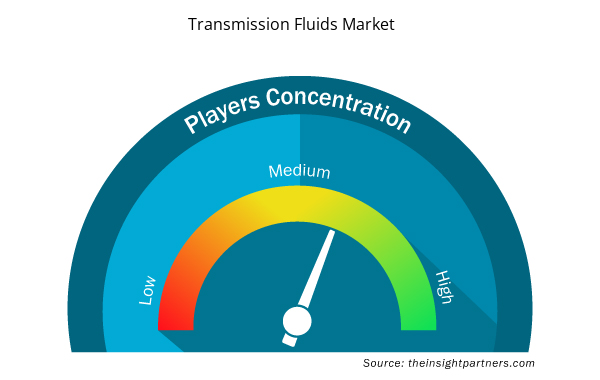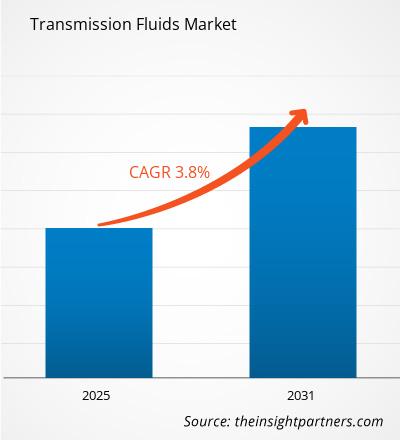预计变速箱油市场在 2024 年至 2031 年期间的复合年增长率为 3.8%,市场规模将从 2024 年的 XX 百万美元扩大到 2031 年的 XX 百万美元。
报告按类型细分(自动变速箱油 (ATF)、手动变速箱油 (MTF)、无级变速箱 (CVT) 油和双离合变速箱油 (DCTF))。报告进一步按应用细分(汽车、工业和其他)。报告进一步根据最终用途行业(乘用车、重型车、越野车和其他)进行了分析。报告范围涵盖五个地区:北美、欧洲、亚太地区、中东和非洲、南美和中美洲以及每个地区下的关键国家。全球分析进一步细分为区域和主要国家。报告以美元为单位提供上述分析和细分的价值。
报告目的
The Insight Partners 撰写的《传动液市场》报告旨在描述当前形势和未来增长、主要驱动因素、挑战和机遇。这将为各种业务利益相关者提供见解,例如:
- 技术提供商/制造商:了解不断变化的市场动态并了解潜在的增长机会,从而能够做出明智的战略决策。
- 投资者:对市场增长率、市场财务预测以及整个价值链中存在的机会进行全面的趋势分析。
- 监管机构:监管市场政策和警察活动,旨在最大限度地减少滥用行为,维护投资者的信任和信心,维护市场的完整性和稳定性。
传动液市场细分
类型
- 自动变速箱油
- 手动变速箱油
- 无级变速器油
- 双离合器变速箱油
应用
- 汽车
- 工业的
- 其他的
终端使用行业
- 乘用车
- 重型车辆
- 越野车
- 其他的
地理
- 北美
- 欧洲
- 亚太
- 南美洲和中美洲
- 中东和非洲
定制此报告以满足您的需求
您可以免费定制任何报告,包括本报告的部分内容、国家级分析、Excel 数据包,以及为初创企业和大学提供优惠和折扣
- 获取此报告的关键市场趋势。这个免费样品将包括数据分析,从市场趋势到估计和预测。
传动液市场增长动力
- Growth of the automotive industry: The global automotive market is still growing, especially in emerging economies like China, India, and Brazil. There is an increasing number of cars on the roads, and the demand for transmission fluids also increases proportionally. Moreover, the continuing growth in the number of vehicles manufactured, especially passenger and commercial, goes hand in hand with advancements in automotive technologies (automatic, dual-clutch, and continuously variable transmissions) that demand specialized fluids. In addition, the increasing number of electric and hybrid automobiles, which require complex transmissions, is another factor behind the increasing market of transmission fluids.
- Advancements to the transmission systems: Continuous technological advancement relates to vehicle transmission systems, such as dual-clutch transmissions (DCT), continuously variable transmissions (CVT), and automated manual transmissions (AMT). Specialist transmission fluids are needed for these technologies. They demand better, higher-performance fluids for smoother gear shifting, less friction, and better fuel efficiency. Manufacturers have improved constantly the formulation of such transmission fluids--for example, by developing synthetic fluids that provide longer-lasting protection, higher-temperature resistance, and better performance under extreme conditions.
- Growing demand for fuel-efficient vehicles: Increasing demands for fuel efficiency and improved vehicle performance. Transmission fluids have an important role here as they minimize friction, contribute towards increasing the life of the overall transmission system, and ensure an optimum shift process. With growing concerns about the environment and stringent regulations for fuel efficiency, high-performance, fuel-efficient transmission fluids have become an important option. These fluids make the vehicle much more effective overall, decrease fuel consumption, and decrease CO2 emission, making them an important product in modern automotive manufacturing.
Transmission Fluids Market Future Trends
- Synthetic transmission fluids: Synthetic transmission fluids have become the most widely used at present since they provide superior performance at extremes, longer intervals, and better wear protection. The adoption of this fluid is significant since consumers and car manufacturers seek more from their vehicle in terms of performance and longevity.
- Hybrid vehicles: Electric vehicles in themselves do not really use classic transmission fluids. Hence, while hybrid vehicles which make use of both electric and internal combustion engines increase the requirement for specific fluids, upgrading of electric drivetrain and high performance hybrid systems requires advanced fluids so that the electric powertrains are going to be efficient and durable.
- Focus on sustainability: With environmental sustainability on the rise, consumers and manufacturers are required to develop alternatives in their automotive products that are sustainable. The manufacturers of transmission fluids have responded with environmentally friendly offerings, including biodegradable fluids and products with a lower environmental impact. Such fluids help reduce emissions by vehicles and promote overall sustainability within the industry, allowing companies to be environmentally sensitive. Packaging for transmission fluids also gains more focus on being recyclable.
Transmission Fluids Market Opportunities
- Demand from developing economies: Emerging markets, particularly in Asia-Pacific, Latin America, and Africa, are growing at a tremendous pace in the automotive sector. This is an attractive proposition for manufacturers in fluid transmission, as demand for automotive fluids will continue to grow in these markets with the increases in vehicle production and ownership. Consequently, demand for high-quality transmission fluids, particularly for passenger and commercial vehicles, will continue to grow.
- Technological innovations: The continuously and increasingly more sophisticated transmission systems, along with the newer dual-clutch transmissions (DCT), continuously variable transmissions (CVT), and hybrid vehicle transmissions, demand new fluids that are specialized for these advanced transmission systems. Companies can reap this benefit by developing fluids that are customized according to the needs of the new, more advanced systems. Increased complexity in automotive drivetrains, therefore creates a large growth opportunity for companies that can provide highly specialized transmission fluids with significant performance characteristics.
- Demand from the aftermarket: With the ever-increasing number of automobiles on the roads and the continued operation of older vehicles for extended periods, there is an increasing demand for aftermarket transmission fluids. Suppliers have a wide window of opportunity in the extensive network of the aftermarket, ranging from auto parts retailers to service centers and online platforms. It suggests a rising opportunity for manufacturers to meet the needs of quality aftermarkets for transmission fluids, particularly in a market where there exists a large quantity of vehicles.
Transmission Fluids Market Regional Insights
The regional trends and factors influencing the Transmission Fluids Market throughout the forecast period have been thoroughly explained by the analysts at Insight Partners. This section also discusses Transmission Fluids Market segments and geography across North America, Europe, Asia Pacific, Middle East and Africa, and South and Central America.

- Get the Regional Specific Data for Transmission Fluids Market
Transmission Fluids Market Report Scope
| Report Attribute | Details |
|---|---|
| Market size in 2024 | US$ XX million |
| Market Size by 2031 | US$ XX Million |
| Global CAGR (2025 - 2031) | 3.8% |
| 史料 | 2021-2023 |
| 预测期 | 2025-2031 |
| 涵盖的领域 | 按类型
|
| 覆盖地区和国家 | 北美
|
| 市场领导者和主要公司简介 |
|
传动液市场参与者密度:了解其对业务动态的影响
传动液市场正在快速增长,这得益于最终用户需求的不断增长,而这些需求又源于消费者偏好的不断变化、技术进步以及对产品优势的认识不断提高等因素。随着需求的增加,企业正在扩大其产品范围,进行创新以满足消费者的需求,并利用新兴趋势,从而进一步推动市场增长。
市场参与者密度是指在特定市场或行业内运营的企业或公司的分布情况。它表明在给定市场空间中,相对于其规模或总市场价值,有多少竞争对手(市场参与者)存在。
在传动液市场运营的主要公司有:
- 巴斯夫
- 英国石油公司
- 雪佛龙公司
- 埃克森美孚公司
- 福斯石油润滑油有限公司
免责声明:上面列出的公司没有按照任何特定顺序排列。

- 了解传动液市场的主要参与者概况
主要卖点
- 全面覆盖:报告全面涵盖了传动液市场的产品、服务、类型和最终用户的分析,提供了整体概况。
- 专家分析:报告基于对行业专家和分析师的深入了解而编写。
- 最新信息:该报告涵盖了最新信息和数据趋势,确保了其与业务的相关性。
- 定制选项:此报告可以定制以满足特定客户要求并恰当地适应业务策略。
因此,传动液市场研究报告有助于引领解读和了解行业情景和增长前景。尽管可能存在一些合理的担忧,但本报告的总体优势往往大于劣势。
- 历史分析(2 年)、基准年、预测(7 年)及复合年增长率
- PEST 和 SWOT 分析
- 市场规模价值/数量 - 全球、区域、国家
- 行业和竞争格局
- Excel 数据集


- GNSS Chip Market
- Saudi Arabia Drywall Panels Market
- Artificial Intelligence in Defense Market
- Virtual Production Market
- Airport Runway FOD Detection Systems Market
- Long Read Sequencing Market
- Railway Braking System Market
- Flexible Garden Hoses Market
- Public Key Infrastructure Market
- Intradermal Injection Market

Report Coverage
Revenue forecast, Company Analysis, Industry landscape, Growth factors, and Trends

Segment Covered
This text is related
to segments covered.

Regional Scope
North America, Europe, Asia Pacific, Middle East & Africa, South & Central America

Country Scope
This text is related
to country scope.
常见问题
A shift toward synthetic and high-performance transmission fluids is expected to be the key market trend.
The report can be delivered in PDF/Word format, we can also share excel data sheet based on request.
On the basis of geography, the transmission fluids market is classified into North America, Europe, Asia Pacific, Middle East and Africa, and South and Central America
The major factors driving the transmission fluids market are:
1. Growth in Automotive Production and Sales.
2. Technological Advancements in Transmission Systems.
ExxonMobil Corp, Shell Plc, Chevron Corp, Castrol India Ltd, TotalEnergies SE, Valvoline Inc, Liqui Moly, Fuchs SE, and Amsoil Inc
The Transmission Fluids Market is estimated to witness a CAGR of 3.8% from 2023 to 2031
Trends and growth analysis reports related to Chemicals and Materials : READ MORE..
1. BASF SE
2. BP plc
3. Chevron Corporation
4. Exxon Mobil Corporation
5. FUCHS PETROLUB SE
6. Petroliam Nasional Berhad (PETRONAS)
7. PJSC LUKOIL
8. Royal Dutch Shell plc
9. The Lubrizol Corporation
10. TOTAL S. A.
The Insight Partners performs research in 4 major stages: Data Collection & Secondary Research, Primary Research, Data Analysis and Data Triangulation & Final Review.
- Data Collection and Secondary Research:
As a market research and consulting firm operating from a decade, we have published and advised several client across the globe. First step for any study will start with an assessment of currently available data and insights from existing reports. Further, historical and current market information is collected from Investor Presentations, Annual Reports, SEC Filings, etc., and other information related to company’s performance and market positioning are gathered from Paid Databases (Factiva, Hoovers, and Reuters) and various other publications available in public domain.
Several associations trade associates, technical forums, institutes, societies and organization are accessed to gain technical as well as market related insights through their publications such as research papers, blogs and press releases related to the studies are referred to get cues about the market. Further, white papers, journals, magazines, and other news articles published in last 3 years are scrutinized and analyzed to understand the current market trends.
- Primary Research:
The primarily interview analysis comprise of data obtained from industry participants interview and answers to survey questions gathered by in-house primary team.
For primary research, interviews are conducted with industry experts/CEOs/Marketing Managers/VPs/Subject Matter Experts from both demand and supply side to get a 360-degree view of the market. The primary team conducts several interviews based on the complexity of the markets to understand the various market trends and dynamics which makes research more credible and precise.
A typical research interview fulfils the following functions:
- Provides first-hand information on the market size, market trends, growth trends, competitive landscape, and outlook
- Validates and strengthens in-house secondary research findings
- Develops the analysis team’s expertise and market understanding
Primary research involves email interactions and telephone interviews for each market, category, segment, and sub-segment across geographies. The participants who typically take part in such a process include, but are not limited to:
- Industry participants: VPs, business development managers, market intelligence managers and national sales managers
- Outside experts: Valuation experts, research analysts and key opinion leaders specializing in the electronics and semiconductor industry.
Below is the breakup of our primary respondents by company, designation, and region:

Once we receive the confirmation from primary research sources or primary respondents, we finalize the base year market estimation and forecast the data as per the macroeconomic and microeconomic factors assessed during data collection.
- Data Analysis:
Once data is validated through both secondary as well as primary respondents, we finalize the market estimations by hypothesis formulation and factor analysis at regional and country level.
- Macro-Economic Factor Analysis:
We analyse macroeconomic indicators such the gross domestic product (GDP), increase in the demand for goods and services across industries, technological advancement, regional economic growth, governmental policies, the influence of COVID-19, PEST analysis, and other aspects. This analysis aids in setting benchmarks for various nations/regions and approximating market splits. Additionally, the general trend of the aforementioned components aid in determining the market's development possibilities.
- Country Level Data:
Various factors that are especially aligned to the country are taken into account to determine the market size for a certain area and country, including the presence of vendors, such as headquarters and offices, the country's GDP, demand patterns, and industry growth. To comprehend the market dynamics for the nation, a number of growth variables, inhibitors, application areas, and current market trends are researched. The aforementioned elements aid in determining the country's overall market's growth potential.
- Company Profile:
The “Table of Contents” is formulated by listing and analyzing more than 25 - 30 companies operating in the market ecosystem across geographies. However, we profile only 10 companies as a standard practice in our syndicate reports. These 10 companies comprise leading, emerging, and regional players. Nonetheless, our analysis is not restricted to the 10 listed companies, we also analyze other companies present in the market to develop a holistic view and understand the prevailing trends. The “Company Profiles” section in the report covers key facts, business description, products & services, financial information, SWOT analysis, and key developments. The financial information presented is extracted from the annual reports and official documents of the publicly listed companies. Upon collecting the information for the sections of respective companies, we verify them via various primary sources and then compile the data in respective company profiles. The company level information helps us in deriving the base number as well as in forecasting the market size.
- Developing Base Number:
Aggregation of sales statistics (2020-2022) and macro-economic factor, and other secondary and primary research insights are utilized to arrive at base number and related market shares for 2022. The data gaps are identified in this step and relevant market data is analyzed, collected from paid primary interviews or databases. On finalizing the base year market size, forecasts are developed on the basis of macro-economic, industry and market growth factors and company level analysis.
- Data Triangulation and Final Review:
The market findings and base year market size calculations are validated from supply as well as demand side. Demand side validations are based on macro-economic factor analysis and benchmarks for respective regions and countries. In case of supply side validations, revenues of major companies are estimated (in case not available) based on industry benchmark, approximate number of employees, product portfolio, and primary interviews revenues are gathered. Further revenue from target product/service segment is assessed to avoid overshooting of market statistics. In case of heavy deviations between supply and demand side values, all thes steps are repeated to achieve synchronization.
We follow an iterative model, wherein we share our research findings with Subject Matter Experts (SME’s) and Key Opinion Leaders (KOLs) until consensus view of the market is not formulated – this model negates any drastic deviation in the opinions of experts. Only validated and universally acceptable research findings are quoted in our reports.
We have important check points that we use to validate our research findings – which we call – data triangulation, where we validate the information, we generate from secondary sources with primary interviews and then we re-validate with our internal data bases and Subject matter experts. This comprehensive model enables us to deliver high quality, reliable data in shortest possible time.


 获取此报告的免费样本
获取此报告的免费样本